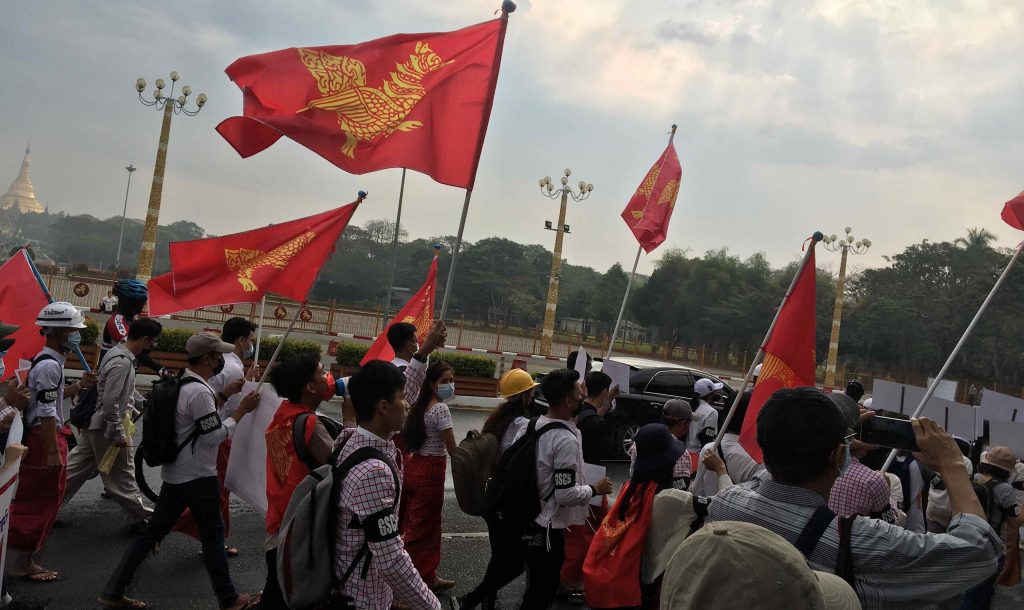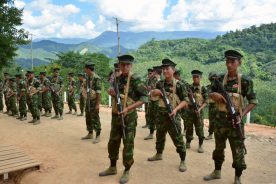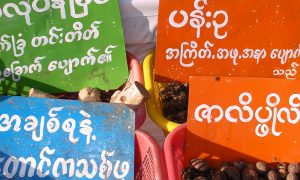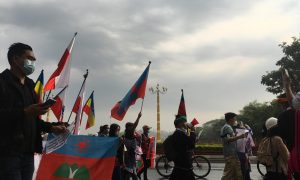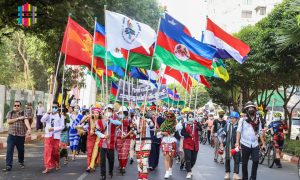In the aftermath of 2021 February military coup there are widespread calls from civil society in Myanmar to overcome previous ethnic, religious and class differences and to consolidate the national unity movement against the common enemy – the Tatmadaw (Burmese army). Yet there is little to no sign of a coordinated countrywide resistance against the common enemy. This article considers the narrative surrounding the common enemy in Myanmar anti-military resistance: is it sufficient to recognise ethnic groups’ demands for self-determination, autonomy and equality?
Nonviolent protest and armed resistance have both been a feature of the response to the coup. However, the priorities of the Bamar ethnic majority and other ethnic groups have differed since the start of protests. The Bamar united under the flag of the National League for Democracy (NLD), demanding the release of Aung San Suu Kyi and other detainees, and respect for the results of the 2020 election held under the controversial 2008 constitution. Meanwhile, ethnic minorities have demanded the abolition of the 2008 constitution and the establishment of a genuine federal democratic union.
Thus, many ethnic minorities’ armed groups, prominent in fighting the Tatmadaw, are cautious about openly joining the movement. Some large ethnic minority organisations are sympathetic and support the ongoing struggle, yet do not wish to form a unified coalition against the common enemy. Others have expressed neither support nor condemnation of the coup. However, this doesn’t mean that there is no way to unify the ethnic groups. Consensus exists around federalism, but it needs a framework that all groups would support.
Baggage From the Past
In the past, the majority Bamar were not concerned about the atrocities taking place in the ethnic minorities’ areas. However, since the coup their ideal scenario has been for the ethnic armed organisations (EAOs) to endorse and support the people’s Spring Revolution under the leadership of the National Unity Government (NUG) in their struggle to reverse the Tatmadaw’s seizure of power. In a formal message sent on Christmas Eve in 2021, the Committee Representing Pyidaungsu Hluttaw (CRPH) urged to continued, unified cooperation despite ethnic and religious differences, to defeat the common enemy as soon as possible.
CRPH is a body composed largely of the NLD representatives elected to the Union Parliament (Pyidaungsu Hluttaw) in the November 2020 election, formed as part of political efforts to oppose the Tatmadaw. It then launched NUG, with senior NLD figures at its centre, but including a few lawmakers elected from the ethnic minorities’ parties in 2020. Within the NUG, senior NLD figures Aung San Suu Kyi and Win Myint retain their posts at the helm (as State Counsellor and President respectively), even though they are in prison.
Aung San Suu Kyi is the daughter of Burma’s independence hero, General Aung San. In 1991, while under house arrest under the previous military government, she was awarded Nobel Peace Prize as a beacon for human rights and democracy. She has been hugely popular among the country’s Buddhist majority, who saw her as a force that would propel Burma towards democratic transition. However, for the ethnic minorities in the country, she has been a democratic dictator.
When Aung San Suu Kyi came to power after the historic 2015 election that NLD won with a landslide, there was some competition between her government and the military over the control of the bureaucracy. However, she was indifferent to the Tatmadaw’s actions as a colonising force in multiple ethnic minority areas since Myanmar’s independence in 1948. Minority ethnic groups have been subjected to horrific atrocities including massacres, sexual violence, torture, forced labor and displacement by the Tatmadaw as well as state-sanctioned discrimination. Aung San Suu Kyi sought to appease and compromise with the Tatmadaw and even implicitly supported its genocide of the Rohingya. Her attitude reflected the lack of empathy by the Bamar majority for many ethnic communities that had long suffered abuses by the Tatmadaw.
In the period of the so-called democratic transition (2011-2021), certain ethnic minority political forces chose to collaborate with NLD and supported their electoral campaign. But the authoritarian behaviour of the NLD government has restricted political movements of the ethnic people. It mistreated less powerful groups and neglected their political demands in Parliament just as the Tatmadaw-backed Union Solidarity and Development Party (USDP) did in the first half of the transition period.
Common Enemy Narratives
In the common enemy narrative, all blame for the suppression of minorities is projected onto the Tatmadaw. The fact that Suu Kyi and NLD failed to guarantee political, social, and economic rights of the ethnic minorities is forgotten. The CRPH messages on both Christmas Eve and Eid al-Fitr continued the narrative that the Tatmadaw is solely responsible for perpetual persecution and atrocities against the ethnic and religious minorities in the country.
Meanwhile, Rohingya genocide deniers are now part of the NUG despite never officially apologising to the public for their misjudgment and for inciting hatred. This includes Dr. Win Myat Aye, former social welfare minister of the country, now serving as the Union Minister of Humanitarian Affairs and Disaster Management at the NUG, and Khin Ma Ma Myo, current NUG Minister of Commerce.
The common enemy narrative is also tangled with the populist characteristics of Suu Kyi’s NLD when it was in power. For the Bamar majority, the NUG is overwhelmingly the institutional leader representing the general will of the people in the Spring Revolution, as NLD did before the coup. NUG denies the existence of diverse opinions and interests among the people. Division of opinions on the formation and work of NUG is often seen as causing disunity. Anyone with different views faces censure. The common enemy narrative thus fails to demonstrate that the goal of the revolution is to find a solution by listening to different voices rather than forcing all the people to unite.
Insufficiency of Common Enemy Narrative
Ethnic groups have taken different political and military positions despite the widespread belief that the coup has unified different forces against the common enemy. Some groups are concerned about the NUG’s position on Bamar political dominance, e.g., whether they would create equal political space for the ethnic groups. Others think of the coup as an internal affair of the Bamar majority and distance themselves from the ongoing crisis.
On May 2021, National Unity Government (NUG) announced that it had formed a People’s Defense Force (PDF) with an array of anti-coup protesters and students opposed to the junta as the military wing of the organisation. In a statement, it said that the move was a precursor to establishing a Federal Union Army (FUA) together with Ethnic Armed Organizations (EAOs) to make effective reforms in the security sector in order to terminate the 70-year-long civil war. But it has been more than a year and there is no sign that FUA will materialise.
There are at least eighteen active EAOs who have been fighting the Tatmadaw for self-determination. Only a few of them are considered in this article due to their positions de facto government with well-structured civil administration in certain ethnic minority areas. Some major EAOs, such as the Kachin Independence Organization/ Army (KIO/ KIA) and Karen National Union (KNU), supported anti-coup protesters and sheltered civil servants taking part in the Civil Disobedience Movement (CDM), and protesters fleeing to the borderlands to avoid arrest and regroup. They also provided some military training and arms to the PDFs who hope to return to cities and towns across the country to defend themselves against the military. But among the EAOs neither strong political nor military collaboration has emerged to form an alliance with PDFs against the common enemy.
KNU, Myanmar’s oldest EAO, was one of the first armed groups to condemn the military coup and the first to publicly reject formal peace talks with the junta. Yet the group is cautious about collaborating with the NUG and expressed concerns about the political dominance of Bamar in the NUG. Padoh Taw Nee, Head of Foreign Affairs for the Karen National Union (KNU), told the Globe that “Ethnic nationalities are participating in the NUG, but we can’t see the substantial result that we had expected.” He also added that they “do not see this as a genuine attempt to create an ethnically diverse body.”
KIO/KIA is also dubious about the NUG’s position on the tyranny of the Bamar majority. The KIA’s chief of staff, General Gam Shawng Gunhtang still needed to urge NUG to commit to establish a genuine federal democracy even after almost a year after the formation of NUG. General N’Ban La, Chairman of KIO, also urges an end to racism among the Bamar in order to work together on ending dictatorship and for a true democracy in Myanmar. To this day, the group has barely made any public statement supporting the CRPH or the NUG.
These two armed groups have been the closest to the anti-coup movement and NUG as well as conducting coordinated operations with the PDF. They have been engaging in regular clashes with the Tatmadaw, yet mainly to regain their own lost territory and not to support the NUG.
Other groups like United Wa State Army (UWSA) and Arakan Army (AA) think that the coup is essentially an intra-Bamar civil-military struggle for power as the Burmese military and National League for Democracy are both predominantly ethnic Bamar. In the wake of the coup, they remained silent and have distanced themselves from both the NUG’s federal democratic vision and the junta’s military-dominated future polity.
Has the coup has brought these groups closer together or deepened disunity, and reduced the likelihood of the formation of the federal army?
New friends, old enemies: Politics of Ethnic Armed Organisations after the Myanmar Coup
UWSA openly announced that they will take no sides regardless of whoever rules the country as it is an internal matter for the Bamar. In recent peace talks with the Tatmadaw, which were declared illegal by the NUG, the Wa delegation stated that UWSA will not cooperate with either the Tatmadaw regime or the NUG regarding the ongoing crisis.
AA are also seen as bystanders. This is because the AA’s commander-in-chief General Twan Mrat Naing urged people in Rakhine State not to participate in the CDM or in street protests. AA has continued to largely honor its truce with the Myanmar military since then. Unlike UWSA, AA rejected the Tatmadaw’s invitation for peace talks and considers their relations with the NUG rather friendly at this juncture.
In order to build a coherent alliance, it is important to acknowledge that demands of ethnic minorities often go beyond challenging the rule. Although different groups hold different ideas, a consensus seems to exist in favor of freedom from Tatmadaw rule, of democracy and federalism, and of moving beyond the limits of the hybrid system that defined the political order of the past decade. Hence the NUG needs a clear and concrete road map for federalism where the minorities can picture their rightful positions in a new Myanmar.
Federalism is the Future
On March 2021, CRPH released the new Federal Democracy Charter (FDC) in an effort to convince ethnic armed groups that they have a historic opportunity to build the federal system they have long fought for. The document includes plans to abolish the 2008 Constitution and establish a new Federal Democracy Union, with a high degree of decentralisation and recognition of collective ethnic rights, customs and ownership of resources. It also emphasises equal rights among Myanmar’s states, who would have their own constitutions and legislative and judicial powers.
But there are concerns over the capacity of CRPH to uphold the understanding of genuine federalism as it has never been the priority of its mother-party, NLD whose policy of “Burmese chauvinism”, attempted to position Bamar as the core of the political system. The party refused to share power and to appoint elected candidates from ethnic parties in the ethnic areas. NUG is also following the same footsteps, as ethnic Bamar holds most of the political roles in the self-declared opposition government.
The FDC has received muted and reserved approval from the CDM and some EAOs, in part because it did not address some of the key issues for the ethnic minorities and the EAOs. This has been only the first step of CRPH’s political vision. There has not been any concrete plan for how to divide power between the union government and the states and how to protect sub-minorities within the main minorities living in the seven ethnic states. The NUG also must address the issue of autonomous zones, which cannot be ignored in any future federal system for Myanmar.
NUG will need to clearly demonstrate the allocation of power and responsibility for the judiciary in autonomous states. The role of the judiciary has been an important tools in dividing power and responsibilities between the center and autonomous units in successful federations. A federal constitution with fair division of judicial power can be a strong foundation for a just, free, peaceful and developed society.
The NUG also needs to have a clear vision of how judicially enforceable fundamental rights for marginalised communities will be protected against infringement by both central and constituent unit governments. There must be detailed provisions on the structure of local government to empower minorities within minorities to govern their own affairs, strengthening autonomy for local minority groups within constituent units.
Since the Charter is only a general road map, it is not impossible to resolve issues that require broader clarification and guarantees. However, the NUG needs to cooperate quickly and genuinely with the ethnic groups to reassure them. Once the NUG can guarantee a federal constitution that will satisfy the demands of all minorities, it will be the beginning of unifying all the nationalities in solidarity against the common enemy.
 Facebook
Facebook  Twitter
Twitter  Soundcloud
Soundcloud  Youtube
Youtube  Rss
Rss 